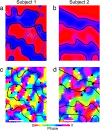High-field fMRI unveils orientation columns in humans
- PMID: 18641121
- PMCID: PMC2492463
- DOI: 10.1073/pnas.0804110105
High-field fMRI unveils orientation columns in humans
Abstract
Functional (f)MRI has revolutionized the field of human brain research. fMRI can noninvasively map the spatial architecture of brain function via localized increases in blood flow after sensory or cognitive stimulation. Recent advances in fMRI have led to enhanced sensitivity and spatial accuracy of the measured signals, indicating the possibility of detecting small neuronal ensembles that constitute fundamental computational units in the brain, such as cortical columns. Orientation columns in visual cortex are perhaps the best known example of such a functional organization in the brain. They cannot be discerned via anatomical characteristics, as with ocular dominance columns. Instead, the elucidation of their organization requires functional imaging methods. However, because of insufficient sensitivity, spatial accuracy, and image resolution of the available mapping techniques, thus far, they have not been detected in humans. Here, we demonstrate, by using high-field (7-T) fMRI, the existence and spatial features of orientation- selective columns in humans. Striking similarities were found with the known spatial features of these columns in monkeys. In addition, we found that a larger number of orientation columns are devoted to processing orientations around 90 degrees (vertical stimuli with horizontal motion), whereas relatively similar fMRI signal changes were observed across any given active column. With the current proliferation of high-field MRI systems and constant evolution of fMRI techniques, this study heralds the exciting prospect of exploring unmapped and/or unknown columnar level functional organizations in the human brain.
Conflict of interest statement
The authors declare no conflict of interest.
Figures






References
-
- Vaughan JT, et al. 7T vs. 4T: RF power, homogeneity, and signal-to-noise comparison in head images. Magn Reson Med. 2001;46:24–30. - PubMed
-
- Ugurbil K, et al. Ultrahigh field magnetic resonance imaging and spectroscopy. Magn Reson Imaging. 2003;21:1263–1281. - PubMed
-
- Lorente de No' R. Architectonics and structure of the cerebral cortex. In: Fulton JF, editor. Physiology of the Nervous System. New York: Oxford Univ Press; 1938. pp. 291–330.
-
- Mountcastle VB. Modality and topographic properties of single neurons of cat's somatic sensory cortex. J Neurophysiol. 1957;20:408–434. - PubMed
-
- Woolsey TA, Van der Loos H. The structural organization of layer IV in the somatosensory region (SI) of mouse cerebral cortex. The description of a cortical field composed of discrete cytoarchitectonic units. Brain Res. 1970;17:205–242. - PubMed
Publication types
MeSH terms
Grants and funding
LinkOut - more resources
Full Text Sources
Other Literature Sources
Medical

